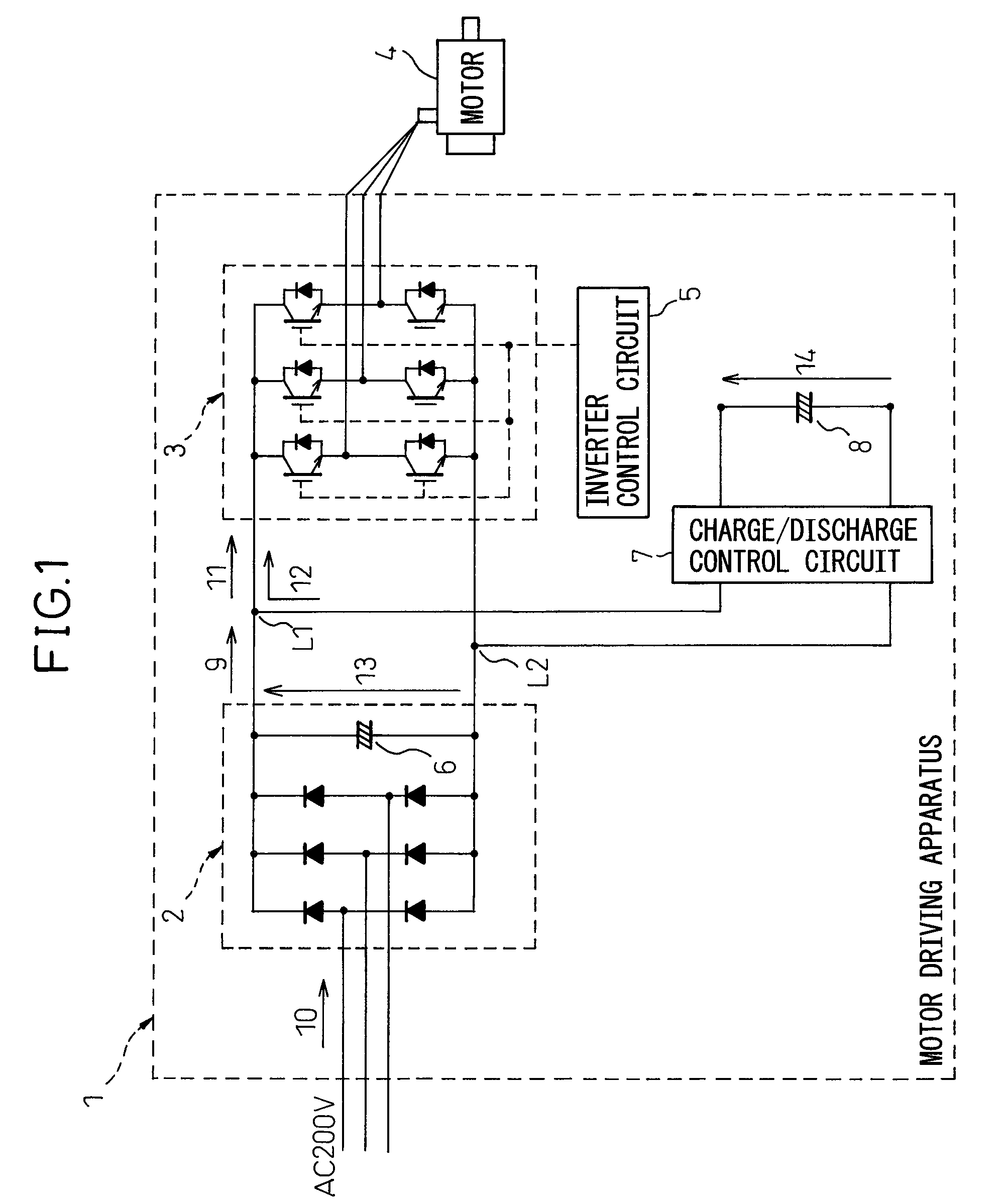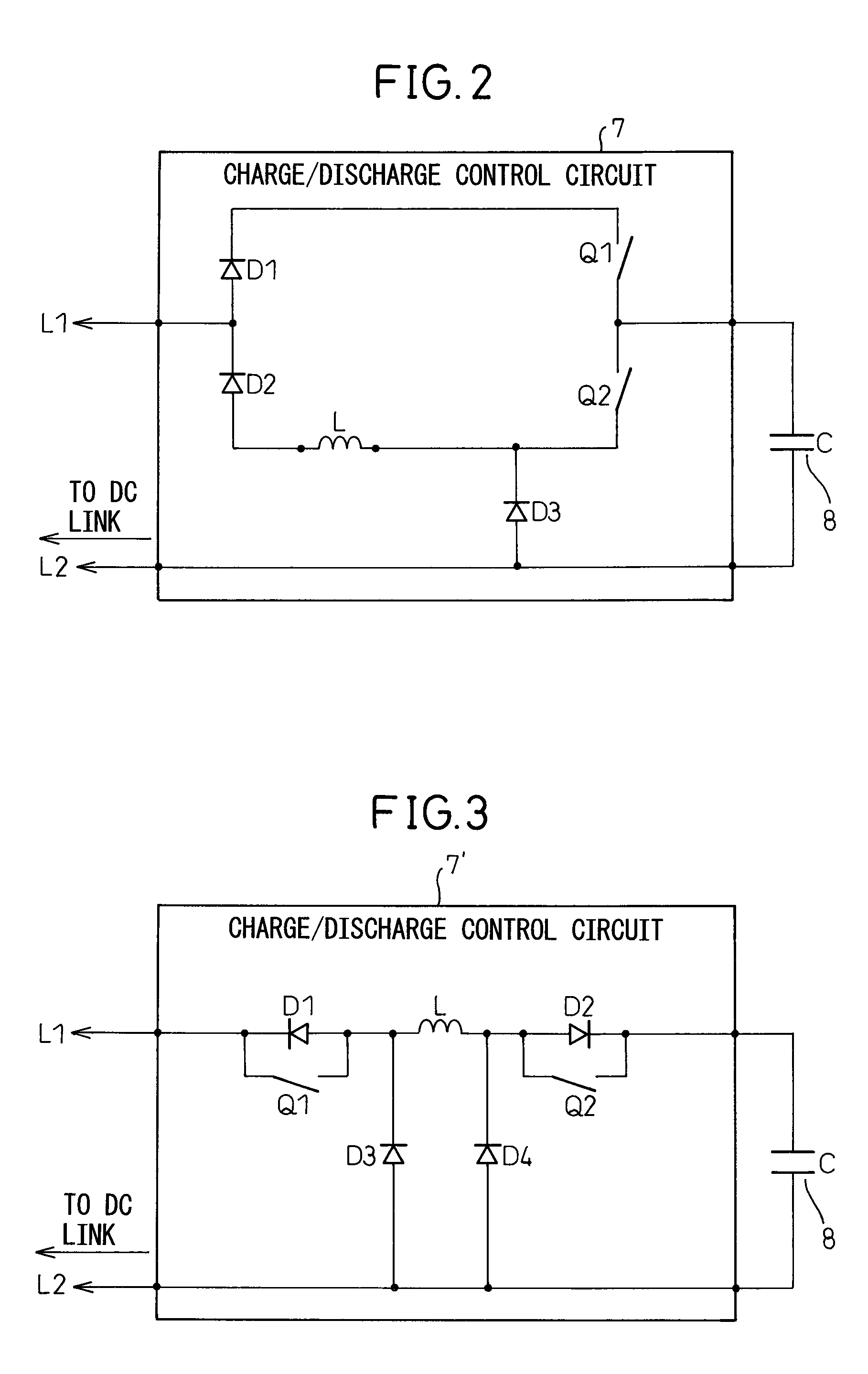Motor driving apparatus
a technology for motors and motors, applied in the direction of motor/generator/converter stoppers, motor/dynamo-electric converter control, electric motor speed/torque regulation, etc., can solve the problem that the electric energy stored in the capacitor b>6/b> is not used efficiently in the motor driving apparatus, and achieves the suppression of the peak of the input current, the reduction of the average power supplied, and the suppression of the voltage drop due to the impedance power supply
- Summary
- Abstract
- Description
- Claims
- Application Information
AI Technical Summary
Benefits of technology
Problems solved by technology
Method used
Image
Examples
first embodiment
[0054]FIG. 2 is a detailed diagram of the charge / discharge control circuit 7 shown in FIG. 1.
[0055]The regenerative energy is stored via the following route:
[0056]Diode D1→Switch Q1→Capacitor C8
[0057]The energy is supplied (the regenerative energy is discharged) via the following route:
[0058]Capacitor C8→Switch Q2→Reactor L→Diode D2→DC link
[0059]In FIG. 2, Q1 and Q2 may be IGBTs or the like.
[0060](Description of Regenerative Energy Storing)
[0061]When the motor 4 begins to decelerate, the regenerative energy is recovered and stored in the capacitor C8 via the diode D1 and switch Q1 in the energy charge / discharge control circuit 7. Power conversion, etc. are not performed on the regenerative energy.
[0062](Description of Energy Supply / Regenerative Energy Discharging)
[0063]When the motor 4 begins to accelerate, the switch Q2 in the energy charge / discharge control circuit 7 is turned on (or switched on and off) with the timing arbitrarily chosen to supply the energy stored in the capacit...
second embodiment
[0065]FIG. 3 is a detailed diagram of the charge / discharge control circuit 7 shown in FIG. 1.
[0066]The regenerative energy is stored via the following route:
[0067]Switch Q1→Reactor L→Diode D2→Capacitor C
[0068]The energy is supplied (the regenerative energy is discharged) via the following route:
[0069]Capacitor C8→Switch Q2→Reactor L→Diode D1→DC link
[0070]In FIG. 3, Q1 and Q2 may be IGBTs.
[0071](Description of Regenerative Energy Storing)
[0072]When the motor 4 begins to decelerate, the regenerative energy is recovered and stored in the capacitor C8 via the switch Q1, reactor L, and diode D2 in the energy charge / discharge control circuit 7′. Power conversion, etc. are not performed on the regenerative energy.
[0073](Description of Energy Supply / Regenerative Energy Discharging)
[0074]When the motor 4 begins to accelerate, the switch Q2 in the energy charge / discharge control circuit 7′ is turned on (or switched on and off) with the timing arbitrarily chosen to supply the energy stored in ...
third embodiment
[0076]FIG. 4 is a detailed diagram of the charge / discharge control circuit 7″ shown in FIG. 1.
[0077]The input current or output current of the converter 2 is monitored by a current sensor or the like not shown, and when the current becomes equal to or exceeds a predetermined current value, the switch Q2 in the charge / discharge control circuit 7 of the first embodiment shown in FIG. 2 or the charge / discharge control circuit 7′ of the second embodiment shown in FIG. 3 is turned on. By monitoring the current in this way, it is determined whether the need has arisen to supply particularly large energy in the second half period of acceleration of the motor 4.
[0078]Next, referring to FIG. 4, an example will be described below in which a determination as to whether the need has arisen to supply particularly large energy in the second half period of acceleration of the motor 4 is made by monitoring a voltage. The voltage developed between the links L1 and L2 connecting the converter 2 and i...
PUM
 Login to View More
Login to View More Abstract
Description
Claims
Application Information
 Login to View More
Login to View More - R&D
- Intellectual Property
- Life Sciences
- Materials
- Tech Scout
- Unparalleled Data Quality
- Higher Quality Content
- 60% Fewer Hallucinations
Browse by: Latest US Patents, China's latest patents, Technical Efficacy Thesaurus, Application Domain, Technology Topic, Popular Technical Reports.
© 2025 PatSnap. All rights reserved.Legal|Privacy policy|Modern Slavery Act Transparency Statement|Sitemap|About US| Contact US: help@patsnap.com



